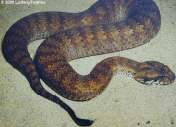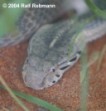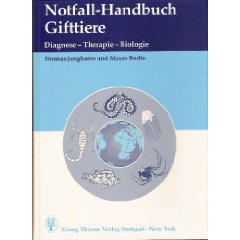|






| |
Acanthophis
antarcticus






Namen: Todesotter; Common death
adder
Alte Namen:
- Boa antarctica
- Acanthophis cerastinus
- Acanthophis brownii
- Boa ambigua
- Ophryas acanthophis
- Vipera sorda
- Acanthophis cerastinus
- Boa aculeata
Unterarten und alte Namen:
- Acanthophis antarcticus antarcticus
- Acanthophis antarcticus cliffrosswelingtoni
- Acanthophis antarcticus schistos
Vorkommen: Australien (New South Wales, Northern Territory, Queensland, South
Australia, Victoria, Western Australia),
Papua Neu Guinea.

Beschreibung:
Trotz ihrer Zugehörigkeit zu den Giftnattern wirken sie eher wie
ein Mitglied der Vipern-Familie. Die Tiere werden bis zu 80 cm lang und tragen
alle Richtungen der Braunfärbungen. Mit dieser Färbung sind sie optimal an ihre
Umgebung angepasst. Sie sind vor allem in der Nacht aktiv. Mit ihrer
Schwanzspitze simulieren sie die Bewegungen von Würmern und locken so ihre Beute
an. Der Biss erfolgt sehr schnell. Bei einer Bedrohung flüchtet die Schlange
nicht und vertraut ihrer hervorragenden
Tarnung. Der Rumpf ist seitlich abgeflacht, kräftig und plump. Der
dreieckige Kopf ist flach, sehr breit und deutlich vom Hals abgesetzt.
Die Giftzähne sind für eine Giftnatter ungewöhnlich beweglich und lang, sie
messen sechs oder mehr Millimeter. Bei Bissen können sie daher senkrecht relativ
tief ins Gewebe eindringen. Die Tiere erreichen eine
durchschnittliche Länge von 60 Zentimetern, maximal 97 Zentimeter.
Toxine:
Postsynaptische Neurotoxine, eine Einwirkung auf die Blutgerinnung ist klinisch
nicht signifikant.
Symptomatik: Jeder
Biss durch die Schlange muss als lebensbedrohlich eingeschätzt werden.
Unbehandelt sollen 50 - 60 % der Bisse tödlich ausgehen. An der Bissstelle kommt
es zu geringen lokalen Schmerzen und Ödemen. Allgemeine Zeichen sind Schwindel,
Kopfschmerzen, Übelkeit, Erbrechen, abdominellen Schmerzen, Durchfall, Krämpfe
und Kreislaufstörungen bis zum Kollaps. Zeichen einer neurotoxischen Symptomatik
sind eine Ptosis, schwere generalisierte Lähmungen und Lähmungen der
Atemmuskulatur.
Maßnahmen:
Hier ist die
"pressure/ immobilization-technique"
anzuwenden. Bei Atemstörungen ist der Patient zu
intubieren und zu beatmen. Die weiteren Maßnahmen erfolgen symptomatisch. In der
Klinik kann eine Dialyse notwendig werden. Es existiert ein Antivenin. Dies ist
erst nach der Rücksprache mit einem Giftinformationszentrums zu geben.
Literatur:
-

-
The Reptile Database
-
WCH Clinical Toxinology
- Todesottern – Wikipedia
- Todesotter – Wikipedia
-
Toxikologische Abteilung, Klinikum Rechts der Isar, München
-
The molecular basis of cross-reactivity in the Australian Snake Venom
Detection Kit (SVDK).
-
Four cases of snake envenomation responsive to death adder antivenom.
-
Species-dependent variations in the in vitro myotoxicity of death adder
(Acanthophis) venoms.
-
Isolation and pharmacological characterization of a phospholipase A2 myotoxin
from the venom of the Irian Jayan death adder (Acanthophis rugosus).
-
Species and regional variations in the effectiveness of antivenom against the
in vitro neurotoxicity of death adder (Acanthophis) venoms.
-
Amino acid sequence of a neurotoxic phospholipase A2 enzyme from common death
adder (Acanthophis antracticus) venom.
-
A pharmacological examination of venoms from three species of death adder
(Acanthophis antarcticus, Acanthophis praelongus and Acanthophis pyrrhus).
-
Characterisation of the biochemical and biological variations from the venom
of the death adder species (Acanthophis antarcticus, A. praelongus and A.
pyrrhus).
-
Modeling of acanthoxin A1, a PLA2 enzyme from the venom of the common death
adder (Acanthophis antarcticus).
-
Purification, characterization, and amino acid sequence determination of
acanthins, potent inhibitors of platelet aggregation from Acanthophis
antarcticus (common death adder) venom.
-
Acanthoxin, a toxic phospholipase A2 from the venom of the common death adder
(Acanthophis antarcticus).
-
Isolation and amino acid sequence of a new long-chain neurotoxin with two
chromatographic isoforms (Aa el and Ae e2) from the venom of the Australian
death adder (Acanthophis antarcticus).
-
Anticholinesterases as antidotes to envenomation of rats by the death adder
(Acanthophis antarcticus).
-
An epidemiological study of snake bite envenomation in Papua New Guinea.
-
The complete amino acid sequence of a post-synaptic neurotoxin isolated from
the venom of the Australian death adder snake Acanthophis antarcticus.
-
Positive response to edrophonium in death adder (Acanthophis antarcticus)
envenomation.
-
Resolution of neurotoxicity with anticholinesterase therapy in death-adder
envenomation.
-
Further studies on the mass of venom injected by Elapid snakes.
-
The amino acid sequence and position of the free thiol group of a short-chain
neurotoxin from common-death-adder (Acanthophis antarcticus) venom.
-
Isolation, properties and amino acid sequence of a long-chain neurotoxin,
Acanthophis antarcticus b, from the venom of an Australian snake (the common
death adder, Acanthophis antarcticus).
-
Isolation and partial characterisation of a lethal neurotoxin from the venom
of the Australian death adder (Acanthophis antarcticus).
-
The death adder (Acanthophis antarcticus)- the effect of the bite and its
treatment.
- Schlangen-
Todesotter, Australische Todesotter -- GORUMA
-
Acanthophis publications
- COLOUR CHANGE IN DEATH
ADDERS (ACANTHOPHIS ANTARCTICUS)
|